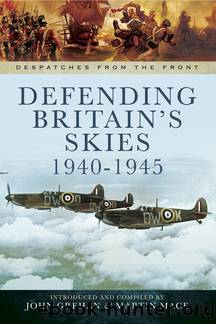Defending Britain's Skies, 1940â1945 by John Grehan Martin Mace

Author:John Grehan, Martin Mace [John Grehan, Martin Mace]
Language: eng
Format: epub
Tags: History, Military, Aviation, World War II
ISBN: 9781473838758
Google: tUIRBQAAQBAJ
Publisher: Pen and Sword
Published: 2014-08-18T04:16:35+00:00
(i) Operation âIntruderâ.
68. The circumstances in which No 23 Squadron began to fly âIntruderâ patrols on 21st December, 1940, have been described above.
69. It was not until the early spring that the squadron had many opportunities of successful action. With better weather and increased enemy activity it was then very successful, claiming the destruction of three enemy aircraft in March, 1941, two in April, and eleven in May. Thereafter, opportunities were again limited. Nevertheless, it was decided that a second âIntruderâ Squadron should be added to the Command, and No. 418 (R.C.A.F.) Squadron, equipped with Bostons, began to form in the autumn.
70. No. 23 Squadron, originally equipped with Blenheims, re-armed with Havocs in March and April, 1941, and received a few Bostons later in the year.
71. Between 21st December, 1940, and 31st December, 1941, operation âIntruderâ was carried out on 145 nights and 573 sorties were flown, of which 505 were by Blenheims, Havocs and Bostons of No. 23 Squadron, and 68 by Hurricanes and Defiants of Nos. 1, 3, 87, 141, 151, 242, 264, 306 and 601 Squadrons, which were employed on this work occasionally on moonlit nights. The destruction of 21 enemy aircraft was claimed, 290 separate bombing attacks on airfields were reported, and ten of our aircraft were lost.
72. Throughout this period the executive control of this operation was something of a problem. To secure the best results, it was essential that the âIntruderâ aircraft should arrive at active enemy bases just as returning bombers reached them. This could only be achieved by a close study of information from intelligence and raid-reporting sources on the part of those responsible for ordering the despatch of the âIntruderâ aircraft. In accordance with the normal practice in my Command, control of the operation was delegated at the outset to No. 11 Group, from whose stations No. 23 Squadron was operating. The executive orders were issued by which ever of the Controllers at No. 11 Groupâs Headquarters happened to be on duty at the time, in consultation with the Officer Commanding No. 23 Squadron. It was a matter for consideration whether these Duty Controllers, with their numerous responsibilities, could be expected to give that constant specialized attention to the changing data provided by the Intelligence and Raid-Reporting services which was essential for success. The suggestion that control of the operation should be exercised directly from my Headquarters was made more than once and from more than one quarter in 1941. I did not think it desirable to make any change at this stage, but later, when the necessity of co-ordinating the work of the âIntruderâ Squadrons closely with the operations of Bomber Command made a more centralised control almost essential, this solution was adopted.
Download
This site does not store any files on its server. We only index and link to content provided by other sites. Please contact the content providers to delete copyright contents if any and email us, we'll remove relevant links or contents immediately.
The Radium Girls by Kate Moore(11921)
100 Deadly Skills by Clint Emerson(4840)
Rise and Kill First by Ronen Bergman(4701)
The Templars by Dan Jones(4627)
The Doomsday Machine by Daniel Ellsberg(4415)
The Rape of Nanking by Iris Chang(4136)
Killing England by Bill O'Reilly(3951)
Hitler in Los Angeles by Steven J. Ross(3900)
Stalin by Stephen Kotkin(3875)
12 Strong by Doug Stanton(3508)
Hitler's Monsters by Eric Kurlander(3268)
Blood and Sand by Alex Von Tunzelmann(3138)
The Code Book by Simon Singh(3073)
Darkest Hour by Anthony McCarten(3070)
The Art of War Visualized by Jessica Hagy(2943)
Hitler's Flying Saucers: A Guide to German Flying Discs of the Second World War by Stevens Henry(2714)
Babylon's Ark by Lawrence Anthony(2620)
The Second World Wars by Victor Davis Hanson(2480)
Tobruk by Peter Fitzsimons(2442)
